Beebom Score
Deck 13 is one of my guilty pleasure game developers and publisher. So when their next title Atlas Fallen was announced, it immediately grabbed my interest even though I have a mixed relationship with The Surge. While I am critical of that game, I cannot stop fawning over its incredible world and gameplay. Atlas Fallen aims to carry that legacy forward. A compelling open and explorable world, with some fun gameplay, a satisfying combat system, and serviceable voice-acting, in the trailers, attracted eyeballs toward Atlas Fallen. But is the game really fun? Are the open world and combat mechanics likable? Let’s find out.
Thanks to an early copy provided by the publisher Focus Entertainment, we have had our hands full with the game for a week. While it does come with its unique shortcomings, Atlas Fallen serves many positives and fun gameplay. So, let’s look at what I liked and what I didn’t in our Atlas Fallen review.
A Tale of a Fallen Empire

Atlas Fallen follows the story of a player-created character and an amnesiac spirit called Nyaal, who are trying to traverse a world that has turned into a barren desert. Ruled by a merciless Sun God, players traverse the harsh environments to help Nyaal regain his memories while upgrading the gauntlet (which houses the spirit of Nyaal) to reach Bastinger, where your friends were destined to travel.
The story follows a typical fantasy RPG setting, where a ruthless ruler oversees the inhabitants. As such, the class hierarchy is in place, which is not heavily touched upon outside the beginning hours, where you are treated like dirt because of your unnamed status. But even later on, the story genuinely did not evoke much interest in me. Throughout my 15-18 hour gameplay session, the plot only left me confused, seeing how much information was dumped throughout the game.
And since there is no proper compendium in-game where you can revisit the past stories, it becomes harder to catch up to the game’s plot and setting while traveling across the deserts and slaying monsters. You do pick up lore items that give you the backstory on the Knights of Bastengar and how the world became like this. But nothing outside of that.
Although the story might not be as appealing, Deck13 tried to make the experience likable through voice acting. Atlas Fallen has full voice acting for every character in-game. While it is not perfect in any sense of manner, and some line delivery sounds awkward, most actors in-game will catch your attention to help you make sense of the story.
Characters are also not memorable, outside of Nyaal, who stays beside you till the end of the game. Other characters hardly captivate your interest, outside of the occasional random quest NPCs you encounter in various ruins. So ultimately, this game lacks any major memorable characters, and if you ask me to tell you my favorite Atlas Fallen character, there is none.
Explore the Desert Plains of Atlas Fallen

One of your primary objectives in Atlas Fallen is to help your ethereal friend regain his memories and strengthen your gauntlet. This results in exploration, done by surfing the sands of the region. A cool mechanic to explore the barren lands and something other developers should have explored earlier. Atlas Fallen’s world is not broad but hits the sweet spot of exploring ruins and camps for items. You can also air-dash in the game whenever you want, especially helpful in crossing wide chasms.
For the most part, your curiosity will make you search for items in this action RPG title. These items can be found buried in item chests, materials scattered around the world, beacons to light up, shards to upgrade your gauntlet, and anvils to dig up. Anvils are checkpoints, which also double as upgrade stations. Some people might think there is not enough to do in the world, and it is true. However, I am glad that Deck 13 didn’t throw in nonsensical checklist item hunts just for the sake of it. Sure, you still do them to create items or momentum stones, but they don’t take the front seat of the experience. And if there is anything I detest in modern gaming, it is checklist item hunting that gets tedious after a while.

If exploring the sandy dunes tire you out, though, we suggest you indulge in story quests. In Atlas Fallen, players can choose between three types of quests — the main quest (colored in Golden), side quests (colored in blue), and errands (colored in green). While the main quests progress the storyline, side-quests, and errands help expand the game’s universe.
Some side-quests generally boil down to saving certain NPCs or gathering certain items, the quality fluctuates quite a bit. However, some of them are intriguing, especially when you have a world like this, and the story’s first half can get confusing. NPCs provide the errand quests, and that involves helping them out.
To incentivize players, finishing the side-quests and errand quests rewards them with items to empower themselves. Furthermore, you can play the quests in any order, whenever you want. There is minimal urgency involved and finishing them awards you with items. Sometimes these can be armors with better stats, items, essence, etc., which can help you quickly turn monsters into fairy dust.
Fast-Paced Hack-n-Slash Gameplay
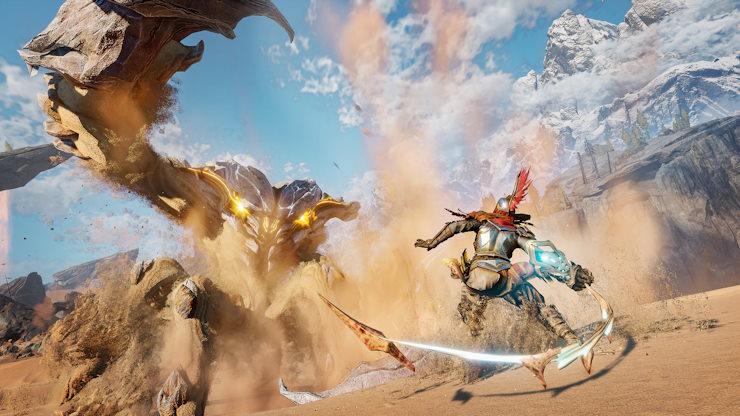
To spice up your exploration in the sandy dunes, enemies pop-up occasionally. Called “Wraiths,” these enemies appear randomly during exploration. Three types exist in Atlas Fallen, and their character design is phenomenal. Lesser Wraiths are common enemies that come to attack you in packs. The Greater Wraiths are the special enemies that occasionally occur on the map. These can summon in lesser wraiths mid-fight. They also have breakable body parts, that drop additional crafting items. Finally, there is Colossal Wraiths, the strongest of the three. These can be classified as the bosses, and rarely appear at specific sections of the map.
To combat these wraiths, there is a hack-n’-slash combat system. It feels eerily similar to THQ Nordic’s Darksiders series, and a little stiff at times. However, the combat system is the strong point of Atlas Fallen, and possibly its saving grace. You can perform four types of attacks. The primary attack, a secondary attack, holding down your primary will let you perform a stronger alternative attack, and finally mid-air juggles. Mixing and matching these attacks will let you perform some cool combos against the enemies. Later on, you can obtain different weapons to switch out, which broadens your arsenal. However, Deck 13 was not satisfied with making just that.
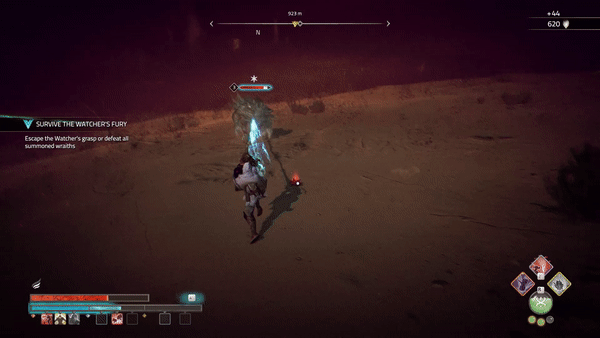
To add variety and depth to the combat, the game also introduces Momentum. A bar below your health that empowers your standard attacks and allows you to use the boons from the selected essence stones. This meter depletes if you take a hit from the enemies or when you are out of combat. The momentum meter also allows you to perform a powerful attack.
Depending on your choice of essence stones, which you gather by exploring and completing quests, your performance in combat changes. Some essence stone allows you to send sand tornadoes toward enemies, improves your defense, and perform unique attacks. The game has the option for you to prepare three presets, each with a different unlocked weapon, essence stones, and idols.
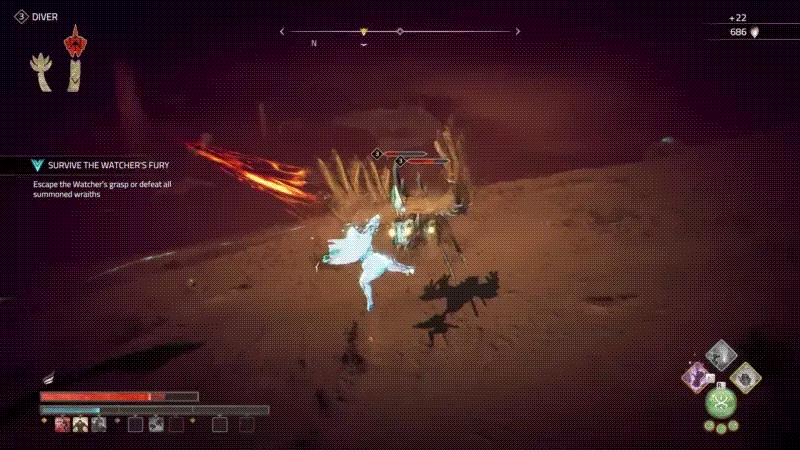
Additionally, you can switch between your three presets at any time outside a fight, further expanding the combat of Atlas Fallen. It encourages you to experiment, not restricting yourself to a particular style. Those quick-witted can leverage this system to perform crazy fight encounters, and I cannot wait to see clips shared online. Deck 13 always leaves room for players to experiment with its game system, and Atlas Fallen is no different.
Forceful Upgrade System
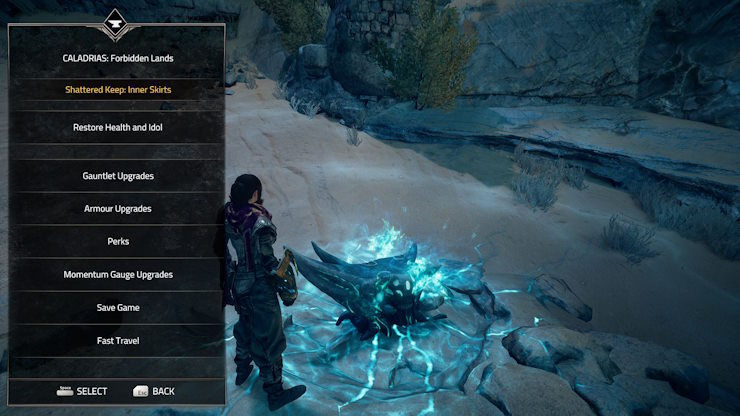
Upgrading in the game is done through Anvils you unearth throughout the game. Here, you can upgrade your armor, gauntlet, unlock slots for the Momentum Gauge, and unlock perks. Armor upgrades improve the performance of your armor. To upgrade it, you require essence dust gathered from the fallen Wraiths. Upgrading the armor provides you with perk points, which you can spend on buying a perk for your character. Perks help improve your secondary features, such as better essence dust collection, better momentum generation, more chances of raw plants appearing in the environment, etc.
You also improve your gauntlet through the Anvil using the collected shards. Upgrading your gauntlet allows you to perform better feats, such as air-dashing three times, unearthing heavy objects, etc. Finally, you can unlock more sockets to place additional momentum stones. These again require you to spend essence points.
The upgrade system of Atlas Fallen feels like something added in forcefully at the final stages of development. Outside of the perk system, the game could’ve stood its ground well without these upgrade systems. Once you upgrade each item to a certain point with no more room for scaling, the only reason to visit an Anvil boils down to fast traveling.
Co-op Experience in Atlas Fallen
Atlas Fallen can be played in co-op from start to end with your friend. The game supports an invite-based co-op system, where you can join your friends via their IP address, through randomly generated code in-game, or a Steam invite. To keep the experience fair for both players, each player’s power is matched to the host. So, if your friend has progressed further in-game and procured a better build, you can still invite them and play Atlas Fallen from start to end. The co-op experience was similar to the single-player experience. Except this time around, we have a buddy to fight the monsters we encounter on the journey.
Once the session wraps up, the visiting player gets to either bring their progress over to their own game or discard the progress altogether and stick to their game’s progression. So, if you want to help a friend level up, that is an option. As for the network performance, there was zero lag between the host and the invited player. We tried it once on the same Wi-Fi and then on a different internet system. In both cases, there was no problem with connectivity, and we could join and leave parties instantly.
Atlas Fallen: Graphics & Performance
We tested Atlas Fallen on our desktop PC since we received the PC key for the title. Here are the specifications of the system on which we played the game.
- CPU: AMD Ryzen 5600
- GPU: Nvidia RTX 4070Ti
- RAM: 16GB @ 3000 MHz
- Tested on an SSD, 7500 RPM hard drive

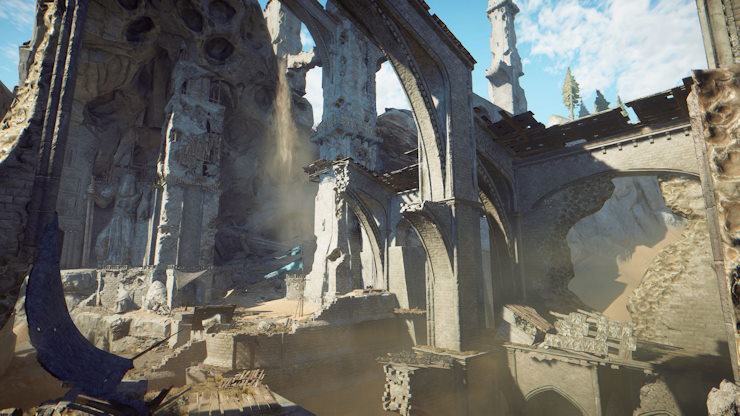
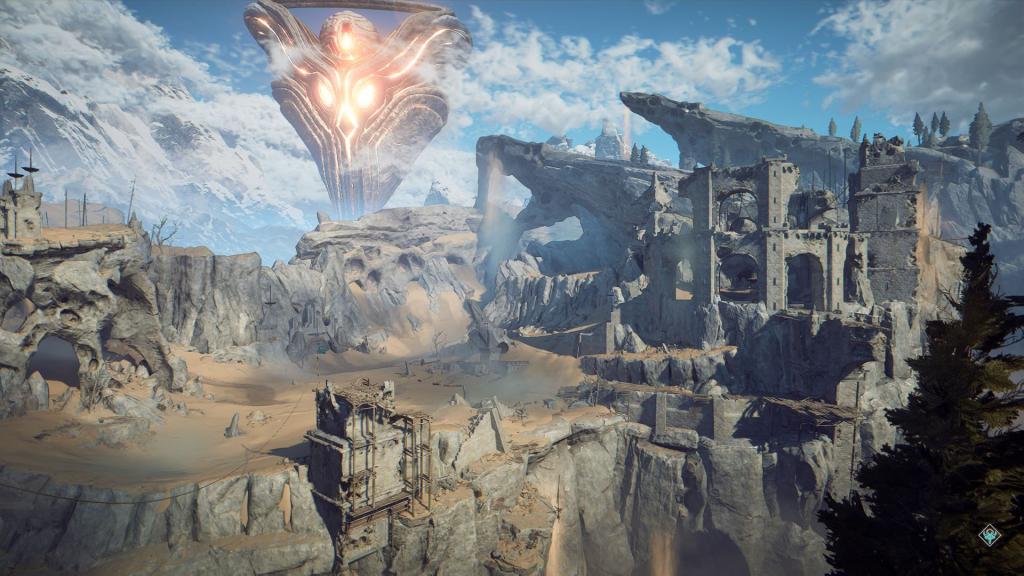
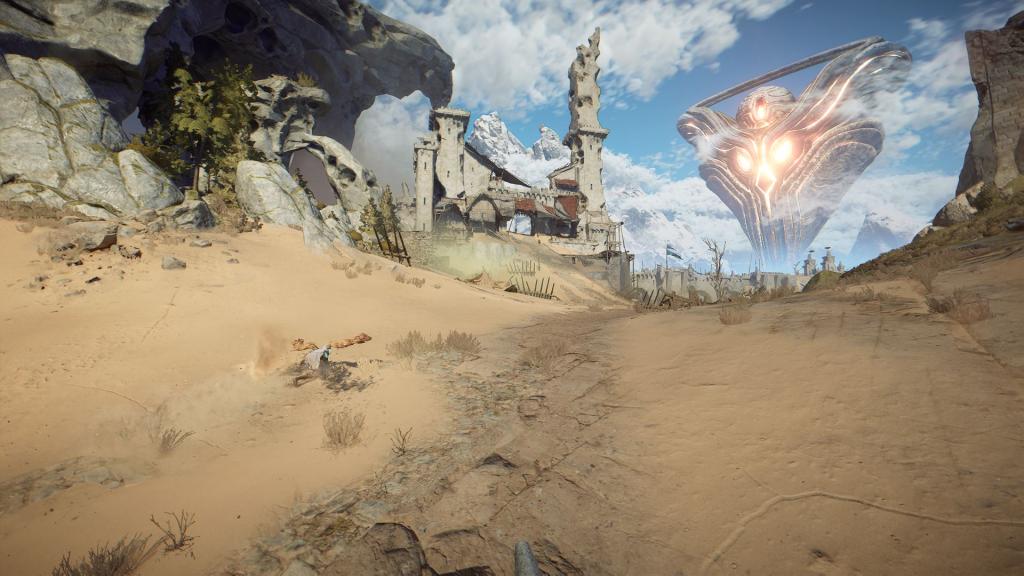

On 1080p/Ultra resolution, Atlas Fallen managed to run at an average of 114 frames per second. We had cranked every setting in the game to max and turned off the motion blur, as it makes me feel uneasy. We did notice some frame drops when we fought several enemies at the same time in quick succession. During those moments, the sand particles were on display, further dropping the frames to 86-87. Of course, from what we know, the developers have confirmed that the performance at launch will be improved.
One thing that we need to mention here is that we did not play the title in DirectX 12. The sole reason for that is the frame drops and micro-stutters. It made playing Atlas Fallen a poor experience on PC, but once I switched to the non-DX12 version, the game ran pleasantly well. Again, an issue that the developers are aware of and have promised to fix on launch day.
We tested the game on an SSD and a hard drive. While the performance of DX12 on a hard drive was much worse, the SSD ran it a tad better. It had noticeably lesser frame dips and stutters. Turning on AMD FSR 2.0 also did not help with the problem. Speaking of which, you have AI scaling options. However, there is no option to select NVIDIA’s DLSS 3.0 or even the older DLSS tech.
Visually, Atlas Fallen looks gorgeous in some scenarios. Graphically, it will not stand toe-to-toe with any current generation PS5 or Xbox title, though. However, it has that distinct AA-title charm and looks gorgeous. On PC, you receive various graphical options to adjust the visuals to your needs.
Atlas Fallen: Should You Buy It to Not?
In the end, in the areas where the Atlas Fallen falters, i.e. the storyline, its open world and combat system make up for it. One thing I love about Deck 13 is their insistence on experimenting with the pre-existing game mechanics introduced in other games. They did that with the combat mechanics in Surge, introducing a limb-targeting system for enemies. They have done the same with Atlas Fallen, redefining the combat style with momentum gauge and momentum slot. The game excels in combat, and while the exploration isn’t spectacular, it’s still charming in its own way.
We recommend you buy Atlas Fallen simply because of its standout combat and gameplay systems. Pick it up whenever you can, especially during sales, and give it a go. You won’t be disappointed. The initial few minutes might disorient you, more so if you play using a keyboard and mouse. However, the game becomes a fun experience once you figure out the sand surfing and momentum mechanics.
Get Atlas Fallen ($49.99)


















